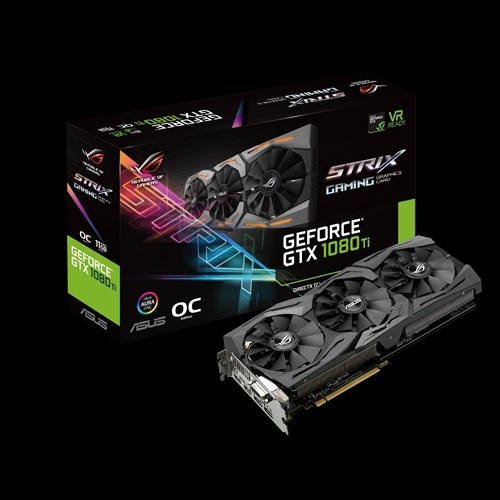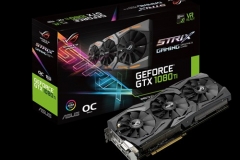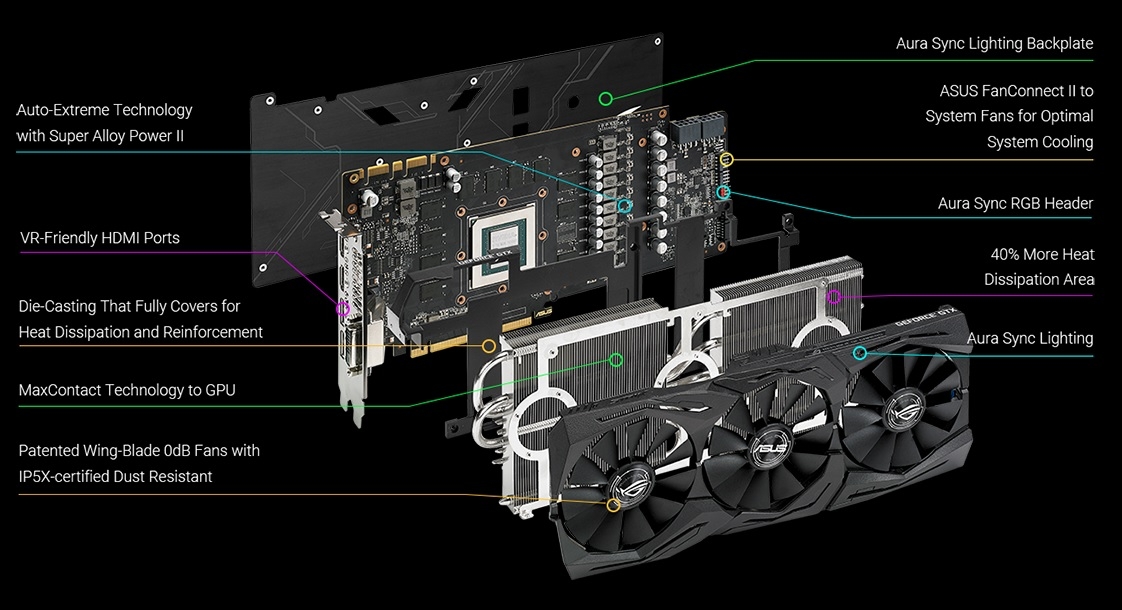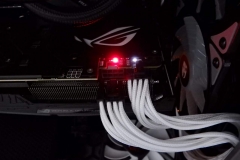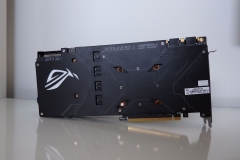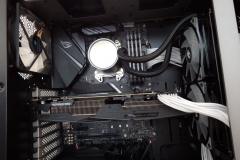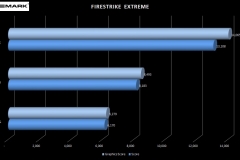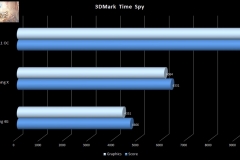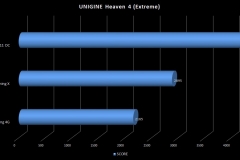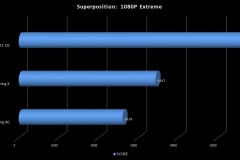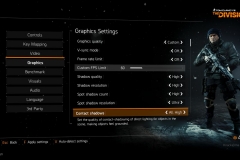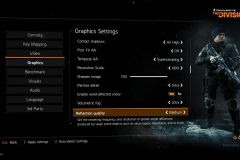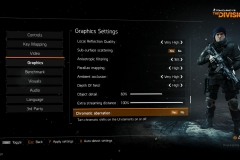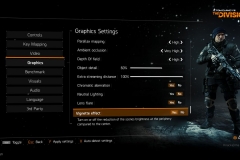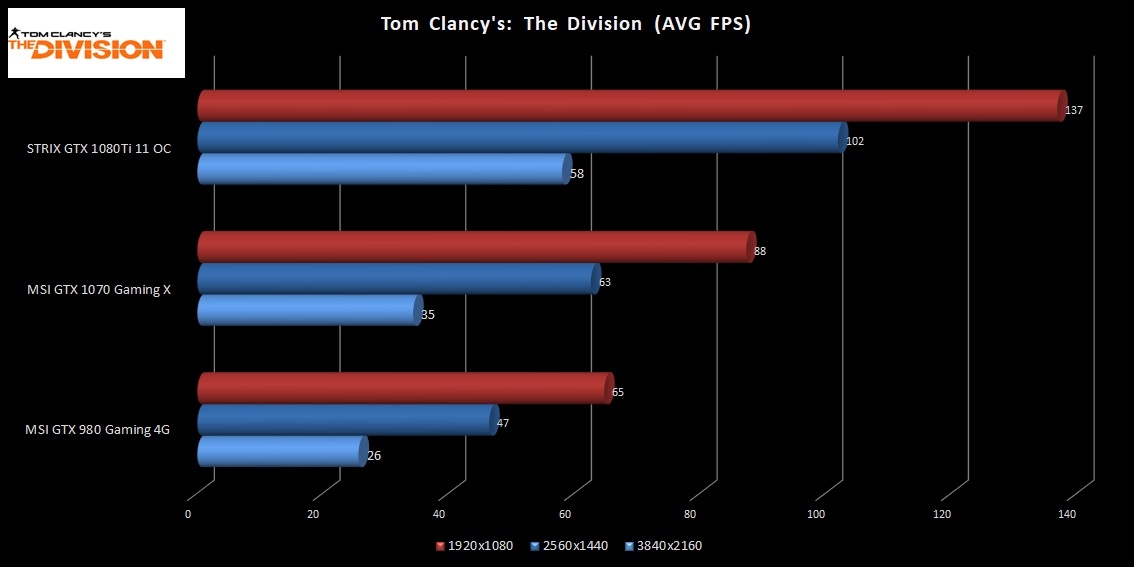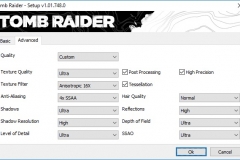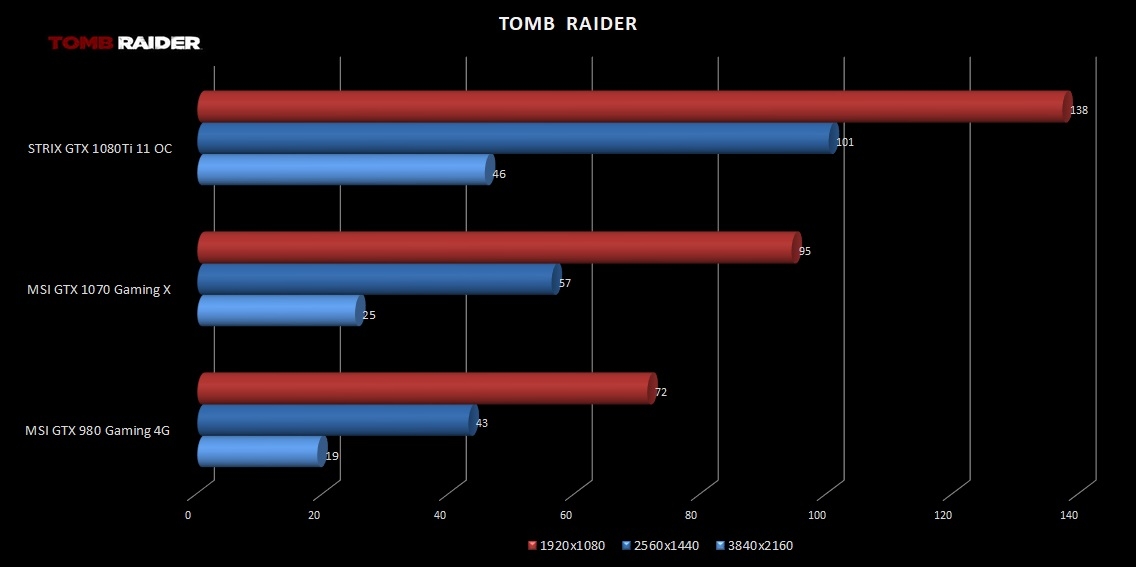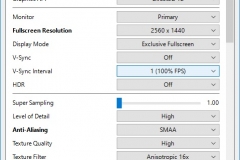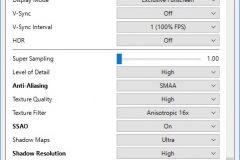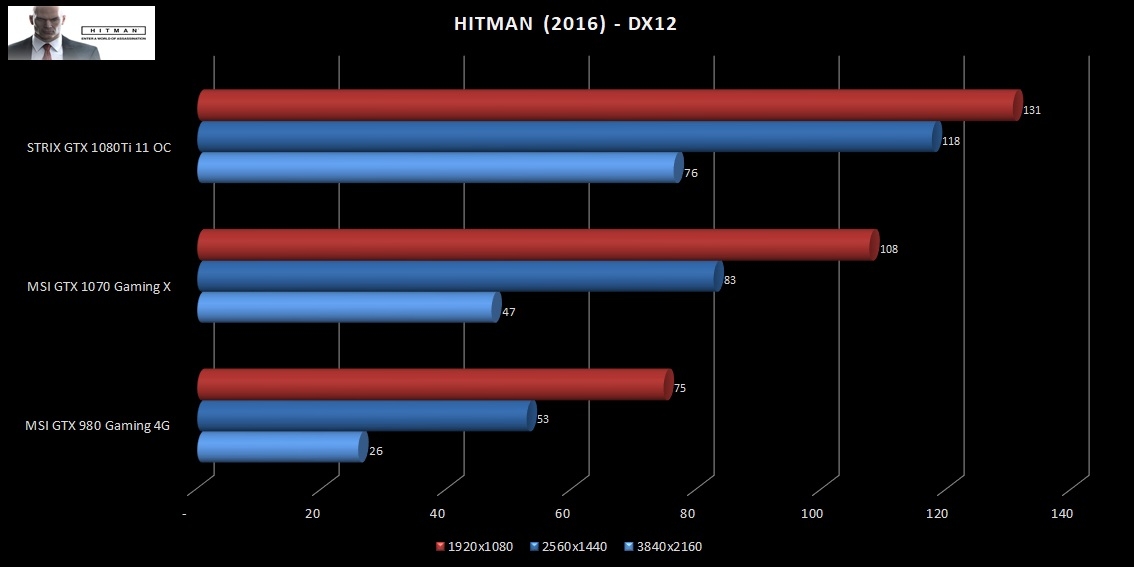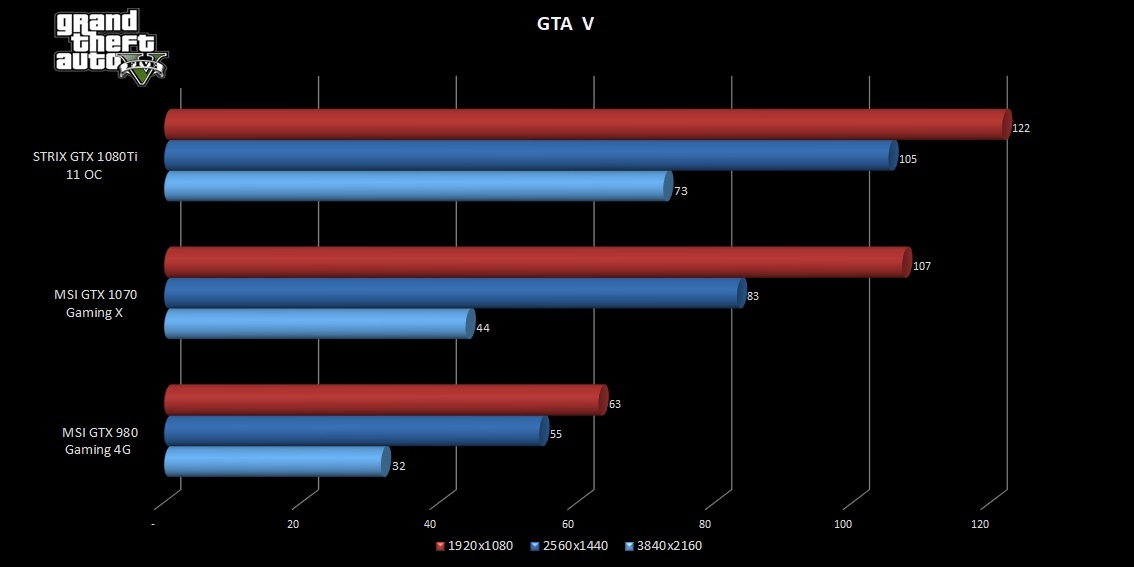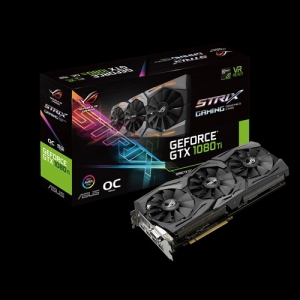Every now and then, something comes through the door here that has me thinking “I know this has to go back when I’m done with it, but I’m going to have to get myself one – I can’t go back now!” The ASUS STRIX Gaming GTX 1080Ti OC 11GB has just enlightened me as to what I’ve been missing with other ‘top-end cards’.
With NVIDIA releasing the RTX 2080 and 2080Ti at excruciating prices, the relative performance benefit against the older GTX 1080Ti doesn’t seem to justify the cost of the new cards for even the enthusiast gamer. The 1080Ti hasn’t seen much in the way of a price drop but it would still be my personal card of choice and if I was buying one tomorrow, odds are that it would be this particular model – the STRIX 1080Ti OC. It handles everything I’ve thrown at it and despite its apparent obsolescence, it brought new life to some games I thought I was done with via 4K performance.
Ray Tracing demos look good – no doubt. NVIDIA has really driven the new technology hard in their media releases but given the current adoption and the likelihood that the next generation of GPUs will be even better at it, I can’t help but lean towards ‘wait and see’… or should that be ‘wait and save‘? By the time the RTX 30xx series are being released, there might actually be some games cemented in the market that make the additional functionality worthwhile.
Anyway let’s get back on point – the ASUS STRIX GTX 1080Ti OC
The GTX 1080Ti was released at a time where 4K monitors were expensive, the GPU itself was expensive compared to the GTX 1080 on launch and then the crypto currency mining boom also pushed it further out of reach (financially and physically available) until now. A “cheap” GTX 1080Ti isn’t cheap at over $1,100 and the STRIX 1080Ti OC is up there with the cream of the crop costing around $1,349. There are affordable 4K monitors available now for under $600 which brings that 60FPS 4K gaming experience down to under $2,000. This is still a lot of money but relatively speaking, CPU’s have held their ground performance wise so for many, this would be the extent of their upgrade on many systems that are up to 3 or 4 years old.
The benchmarks in our testing show why the 1080Ti is so impressive as a GPU but the overall execution by ASUS of the STRIX GTX 1080Ti as a package had me sold. Props to the design team for their attention to detail and consideration for the enthusiast gamer. If the GTX 1080Ti is a long term card, the last thing I’d want is for mine to have traits that irritate me over the journey – traits like fan noise or aesthetics that date, not to mention durability concerns. ASUS has these elements well in hand with their ROG STRIX cooler.
The STRIX cooler is the quietest gaming-grade graphics card I’ve ever seen. The 3 fans do an excellent job of moving air through the fin stack and heat pipes but they don’t need to blow like a hurricane to get the job done, at idle they take a break and don’t even spin at all. The heatsink and backplate can get warm but there was no indication of throttling nor did the temperature report a reading over 74C during any of our testing, typically staying under 69C at load.
The heat pipes and fin stack are large but the height profile of the card is shorter than alternative twin fan cards because ASUS has implemented 3 smaller fans instead of 2 larger units. The design makes the card longer but the length isn’t excessive nor does it make the card difficult to manoeuvre into place.
This beast is powered by two 8-pin PCIE power connections but also has two PWM fan headers and an RGB strip header. There are LEDs on the power connectors that glow red if the card is installed but no PCIE power connectors are attached – the LEDs turn white when the card is properly connected and good to go.
The PWM fan headers are important – regardless of your motherboard, if you want to rig up some fans in your case with the focus of moving air over the graphics card, ASUS has provided the means to do it. The more air you pass across the STRIX cooler with backplate, the more efficient the cooler will run which results in lower GPU fan speeds, less noise (not that it makes much anyway) and even lower temperatures.
I ran our card with a Ryzen 2700X 8 core/16 thread CPU comfortably using a 750W power supply. The power draw from the wall was typically 390W under load but it did peak at 407W during our gaming benchmarks and idled at about 95-100W.
Specification
| Graphics Engine | NVIDIA GeForce GTX 1080 TI |
|---|---|
| Bus Standard | PCI Express 3.0 |
| OpenGL | OpenGL®4.5 |
| Video Memory | GDDR5X 11GB |
| Engine Clock | OC Mode - GPU Boost Clock : 1708 MHz , GPU Base Clock : 1594 MHz Gaming Mode (Default) - GPU Boost Clock : 1683 MHz , GPU Base Clock : 1569 MHz |
| CUDA Core | 3584 |
| Memory Clock | 11100 MHz (OC Mode) 11010 MHz (Gaming Mode) (Default) |
| Memory Interface | 352-bit |
| Resolution | Digital Max Resolution:7680x4320 |
| Interface | DVI Output : Yes x 1 (Native) (DVI-D) HDMI Output : Yes x 2 (Native) (HDMI 2.0b) Display Port : Yes x 2 (DisplayPort 1.4) HDCP Support : Yes (2.2) |
| Power Connectors | 2 x 8-pin |
| Accessories | 1 x ROG Velcro Hook & Loop 1 x Power cable 1 x CD 1 x Quick Guide |
| Software | ASUS GPU Tweak II & Driver Aura(Graphics Card)Utility |
| Dimensions | 11.73 " x 5.28 " x 2.07 " Inch 29.8 x 13.4 x5.25 Centimeter |
| Note | . To have the best cooling performance, ASUS STRIX-GTX1080TI extends the fansink to 2.5 slots. Please double check you Chassis and Motherboard dimension prior to purchase to make sure it fits in your system! . Note that the actual boost clock will vary depending on actual system conditions. For more information, please visit http://www.geforce.com/ |
Here is the link to ASUS product page
The build quality is also excellent with the card being solid, heavy and not missing a beat during testing. We tested it in 4 different systems during our Threadripper 2950X testing and handled it quite a lot but there was no point where we felt that it was anything but durable.
Test System
For the purpose of testing and benchmarks, we used the ASUS STRIX X470-F Gaming test bench with a Ryzen 2700X CPU.
ASUS ROG Test Rig Specification
- AMD Ryzen 7 2700X
- Deepcool Castle 240RGB water cooler
- 32GB HyperX Predator RGB DDR4 2933
- ASUS ROG STRIX X470-F Gaming Motherboard
- ASUS ROG STRIX GTX 1080Ti OC
- Samsung Evo 840 250GB SSD
- ADATA SX7000 M.2 NVMe 256GB SSD
- Seagate Firecuda 2TB 3.5″ HDD
- Aerocool Project 7 750W 80 Platinum PSU
- In Win 509 Case
- Logitech G910 keyboard
- Logitech G900 mouse
- Logitech Z533 desktop speakers
- Kingston HyperX Cloud headset
- Benq EL2870U 4K Monitor
- ViewSonic XG2703-GS Monitor
Results
Futuremark
The graphics score is more than double the GTX 980 and about 60% better than the GTX 1070.
Unigine
The Unigine Heaven performance is again more than double the performance of the GTX 980 and around 50% more than the GTX 1070 can manage. The gap widened in the Superposition (1080P Extreme) and narrowed a little in the Valley Benchmark (Extreme HD).
Division
The Division was tested with the following settings:
Playing The Division at 1920×1080 or 2560×1440 with the settings cranked up is adequate with a GTX 1070 but the ASUS STRIX GTX1080 Ti OC takes it to a whole new level, delivering an average of almost 60FPS at 4K with high eye candy enabled.
Tomb Raider
The following settings were used to test Tomb Raider and although we expected more from an older title, the difference in frame rate was in line with other tests.
For an older title, the average FPS felt lower than it should be across the board but the drop in FPS from 1440p to 4K was heavy. Even on the mighty GTX 1080Ti OC, some quality setting have to be scaled back a bit to enjoy the game at 4K resolution. That said, the result is still leaps and bounds ahead of the GTX 1070 and GTX 980 comparison results.
Hitman (2016)
We tested in DX12 using the following settings.
The ASUS STRIX 1080Ti OC stood out again here with the 4K performance almost catching the 1440p frame rate of the GTX 1070. The performance hit from 1080p to 1440p wasn’t as much as a percentage as we observed with the other cards and 4K frame rates were still over 70 with the average coming in at 76FPS.
GTA V
GTA V is a lot of fun, affordable and has a solid benchmark. We tested with the settings below:
The results at 4K were better than I’d expected with the GTX 1080Ti OC averaging 73FPS – I’d been hoping for something stable and in the mid-60’s. One surprise here was how close the 1440p and 1080p results were. We did three runs each and the results were consistent with a very minor gap.
General Observations
General gaming at 4K 60FPS was great and most titles were able to maintain an average FPS of at or just under 60FPS at Very high or Ultra settings and it doesn’t take much tweaking and only the occasional minimal sacrifice to get the extra few FPS that you need to average 60FPS at 4K. There will always be exceptions but in the titles I played, the experience was addictive.
The ASUS STRIX test platform was a good example of the ASUS ROG gaming experience and I appreciated the acoustic profile of the test system in that it barely made a sound whilst delivering clear audio via the SupremeFX solution on the X470-F Gaming motherboard. Graphically, the STRIX GTX 1080Ti OC ran quietly but confidently, setting the benchmark for speed and value at the top end.
It’s hard to put into words how well COD Black Ops 3, Battlefields 1 and 4, Elder Scrolls Online, Witcher 3, Path of Exile and Far Cry 5 felt at 4K with maximum settings. This was the most I’ve enjoyed these games to date and with this experience came a sobering, almost depressing realisation – I could have bought this card shortly after launch at about the same price as it currently retails AND had this experience for almost 18 months.
Pricing
Make no mistake, it’s pricey – even expensive but the difference between the 1070 and the 1080Ti is generally significant and if 4K gaming is your goal, lesser cards are likely to come up short, requiring the settings pulled back. $1,350 was the cheapest price I could find at the time of writing so it has held its value well.
Final Thoughts
The STRIX GTX 1080Ti OC combined with a 4K display has renewed my interest in many games that I thought I’d laid to rest. To me, there is a lot of value in wanting to replay (or go back and finish) titles in my gaming library.
The STRIX makes very little noise, is well built and aesthetically neutral enough to go in my current or any future builds. Most importantly, the STRIX Gaming GTX 1080Ti OC has delivered the best gaming experience I’ve had to date and it didn’t feel like it was struggling – I know all graphics cards have to age but this one still feels in its prime. It was probably a 5-year card when released so now I guess it’s maybe a 3-year card?
There is still a value in obtaining the ASUS STRIX GTX 1080Ti OC at current prices, the RTX 2080 has improved performance but is let down by the cost, availability and inclusion of new features that deliver very little right now. The RTX 2080Ti is a beast of a card but at a cost of $2000 or more, it would want to be.
If you have been tossing up a GTX 1080Ti but waiting to see what the RTX line-up had to offer, there is still plenty of life left in the top GTX card and the ASUS STRIX GTX 1080Ti OC is the cream of the crop.
| ASUS STRIX GTX 1080Ti OC | |
|
PROS |
|
|
CONS |
– Not cheap or in great supply |
| Awards |

